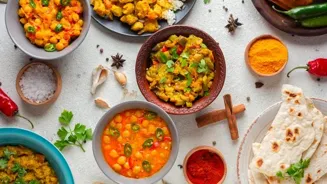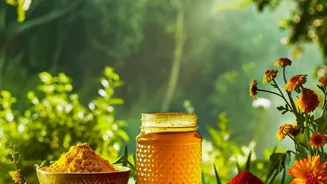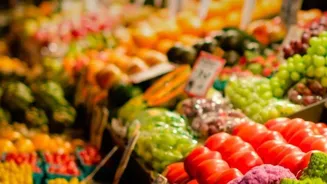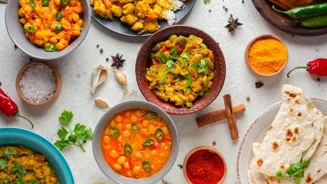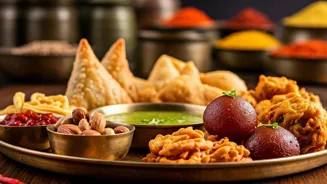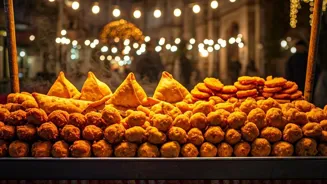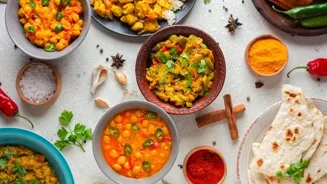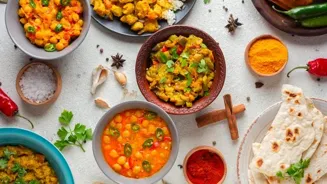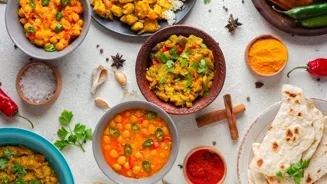Discover the true essence of Indian cuisine beyond just "curry." Dive into the rich tapestry of flavors and spices that define this diverse culinary landscape. From regional variations to intricate spice blends,
Indian food is a celebration of life and community. Let's explore the vibrant world of Indian cuisine together!
For many outside India, and sometimes even within, Indian cuisine is often simplified to just “curry.” While the term isn't incorrect, it's a massive underselling of the incredible diversity and complexity that defines Indian food.
Curry, in its most basic form, simply refers to a dish with a sauce or gravy, typically spiced. But the flavors, ingredients, and cooking methods vary drastically across the country’s regions, resulting in a culinary landscape that is as vibrant and diverse as its people.
It's time we moved beyond this generalization and explored the fascinating world of Indian flavors.
India's diverse regions offer unique culinary identities from wheat-based dishes to fish curries
India is a land of varied climates, landscapes, and cultures, and this diversity is mirrored in its food. From the snow-capped Himalayas to the tropical coastlines, each region boasts its own unique culinary identity.
The fertile plains of the north produce wheat-based dishes like rotis and naan, often served with lentil-based dals and vegetable preparations seasoned with aromatic spices like cardamom, cloves, and cinnamon.
Moving eastward, rice becomes the staple, accompanied by fish curries and vegetable dishes flavored with mustard oil and the unique Bengali spice blend, panch phoron.
Regional Indian cuisine showcases diverse flavors and ingredients
Down south, rice takes center stage again, but this time it's paired with sambar, rasam, and an array of coconut-based vegetable dishes. The use of tamarind lends a distinctive sourness, while mustard seeds and curry leaves add a fragrant touch.
In the west, you'll find a blend of influences, from the sweet and tangy flavors of Gujarat to the spicy and robust dishes of Maharashtra. The use of peanuts, sesame seeds, and jaggery is common, and seafood also plays a significant role in coastal areas like Goa.
This regional differentiation demonstrates that Indian food isn't a monolithic entity but a tapestry woven with distinct flavors reflecting local produce and traditions.
Indian cuisine: diverse spices enhance flavor, aroma, and nutrition
The beauty of Indian cuisine lies not only in its diversity, but also in its intricate use of spices. Spices are not merely flavor enhancers; they are integral to the overall taste, aroma, and even nutritional value of a dish.
A traditional Indian kitchen houses a wide array of spices, each with its own unique properties and purpose. Turmeric, known for its anti-inflammatory benefits, lends a vibrant yellow color and earthy flavor. Cumin adds a warm and aromatic touch, while coriander provides a fresh and citrusy note.
Spice mastery in Indian cooking creates flavorful symphonies
Chili peppers bring the heat, and ginger and garlic add pungency and depth. The art of Indian cooking lies in understanding how these spices interact with each other and how to use them in the right proportions to create balanced and harmonious flavors.
It's a skill passed down through generations, and each family often has its own secret spice blends. The proper use of spices can transform simple ingredients into culinary masterpieces, creating a symphony of flavors that tantalize the taste buds.
Discover lesser-known ingredients shaping Indian cuisine's unique flavors
Beyond the recognizable spices, there are also several lesser-known ingredients that contribute to the unique character of Indian food. Asafoetida, with its pungent aroma, adds a savory umami flavor to dishes. Black salt, with its sulfurous notes, lends a distinctive tang.
Dried mango powder, known as amchur, provides a fruity sourness. These ingredients, along with a variety of regional herbs and vegetables, contribute to the complexity and depth of Indian cuisine. Experimenting with these ingredients can open up a whole new world of flavors.
Indian cuisine: more than food, it's a communal celebration of life
Indian cuisine is not just about the food itself, but also about the experience of eating. Meals are often shared with family and friends, creating a sense of community and togetherness. Food is not just sustenance; it's a celebration of life and a way to connect with loved ones.
Traditional Indian meals are often served on a thali, a large platter that holds various dishes, each representing a different flavor and texture. Eating with your hands is also a common practice, as it is believed to enhance the sensory experience.
The aroma, taste, and texture of the food all come together to create a truly immersive and unforgettable culinary journey. This emphasis on the dining experience adds another layer of richness to Indian food.
Explore the diverse and vibrant world of Indian cuisine beyond "curry."
The world of Indian cuisine is vast and exciting, waiting to be explored. By moving beyond the simple label of "curry," we can discover the incredible diversity, complexity, and depth that this culinary tradition has to offer.
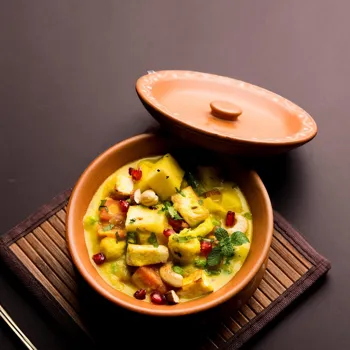
So, the next time you encounter Indian food, take a moment to appreciate the artistry and skill that goes into creating each dish. Embrace the flavors, aromas, and textures, and allow yourself to be transported to the vibrant and enchanting world of Indian cuisine.
It's a journey that is sure to tantalize your taste buds and leave you wanting more.
Indian street snacks: samosas, Pani Puri, Bhel Puri, popular and hygienically prepared
Indian snacks are also part of the culinary experience. Samosas, with potato and peas fillings, are a popular street food. Also there are Pani Puri and Bhel Puri, which can be found in every state in India.These snacks are prepared in a very hygenic manner.
South Indian cuisine widely loved in India, from street food to luxury dining
South Indian cuisine is popular through out India. Idli, Dosa, Vada, Sambar, Uttapam are available from the road streets to five star hotels. This food is liked by people of all age groups. The taste is consistent and flavorful.
Indian sweets variety: Gulab Jamun, Rasgulla, Barfi, Jalebi popular for festivals
Variety of sweets can be found in India. Gulab Jamun, Rasgulla, Barfi, Jalebi are popular among the sweets. Every festivals or any occasion is usually celebrated with these sweets . Every state has a specific sweet and it is consumed on a regular basis.
Indian food showcases diverse regional flavors
Indian food, often simplified as "curry," is a diverse culinary landscape shaped by regional variations. Each region has its distinct flavors and ingredients.
Spices enhance taste and nutrition in cooking
Spices are not just flavor enhancers but integral to the overall taste and nutritional value. A proper usage can create a symphony of flavors.
Explore unique ingredients for flavorful dishes
Beyond common spices, lesser-known ingredients like hing and amchur contribute to the depth of flavors. Experiment to open up a whole new world of food.
